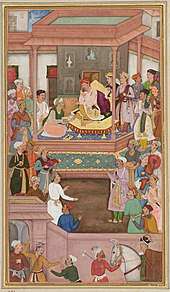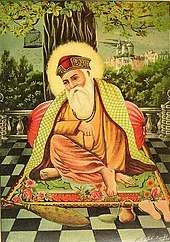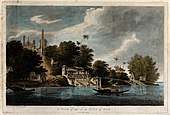Ayodhya is an ancient city located near Faizabad in Uttar Pradesh, India.

Ayodhya is esteemed one of the holiest places of antiquity. ~ Abu Fazl

Mardana! this Ayodhya city belongs to Sri Ramachandra Ji. So let us go for his darshan. - Guru Nanak

Painting of Ayodhya by William Hodges

Ayodhya is as holy to Hindus as Mecca to Muslims. ~ K. K. Muhammed
Quotes
- Ajodhya is one of the largest cities of India... In ancient times its populous site covered an extent of 148 kos in length and 36 in breadth, and it is esteemed one of the holiest places of antiquity. Around the environs of the city, they sift the earth and gold is obtained. It was the residence of Ramachandra who in the Treta age combined in his own person both the spiritual supremacy and the kingly office. ... Near the city stand two considerable tombs of six and seven yards in length respectively. The vulgar believe them to be the resting-places of Seth and the prophet Job, and extraordinary tales are related of them. Some say that at Ratanpur is the tomb of Kabir, the assertor of the unity of God... Ayodhya... is regarded as sacred ground. On the ninth of the light half of the month of Chaitra a great religious festival is held. ... Rama was accordingly born during the Treta Yuga on the ninth of the light half of the month of Chaitra in the city of Ayodhya.
- Ain - I - Akbari Of Abul Fazl-i-allami Vol.ii. (ca. 1590) Quoted from Narain, Harsh (1993). The Ayodhya temple-mosque dispute: Focus on Muslim sources. Delhi: Penman Publishers.
- There are few monuments of any antiquity. Rama’s birthplace is marked by a mosque, erected by the Moghul emperor Babur in 1528 on the site of an earlier temple.
- Encyclopedia Britannica. Entry Ayodhya. Volume 1, 1985. 15th edition Also quoted in Elst, K. in The Ayodhya reference: The Supreme Court judgement and commentaries. (1995)
- In Ayodhya itself, several Rama temples were destroyed by Aurangzeb (Treta-ka-Thakur and Swargdwar), a fact which even the official polemicists against the Rama-Janmabhoomi have not dared to deny.
- Koenraad Elst, Ayodhya: The Case Against the Temple (2002)
- Mardana! this Ayodhya city belongs to Sri Ramachandra Ji. So let us go for his darshan [visit with God].
- Guru Nanak (1469 – 1539) (attributed) as quoted by Bhai Man Singh's Pothi Janam Sakhi (late 18th century), In: Harsh Narain The Ayodhya Temple Mosque Dispute: Focus on Muslim Sources, pp 14-15, 1993, New Delhi, Penman Publications. ISBN 8185504164
- Another version of this account according to B.B.W.J. Sakhi (1883): Bhai Bala! this city belongs to Sri Ramachandra Ji. Here Sri Ramachandra Ji took incarnation and performed (human) deeds. Therefore, walk with caution. Quoted in: Harsh Narain The Ayodhya Temple Mosque Dispute: Focus on Muslim Sources
- Guru Nanak... reached Ayodhya... He gazed at Rama for darsana and then left overjoyed and earning his merit.
- Baba Sukhbasi Ram Bedi, 1829, Quoted from Narain, Harsh (1993). The Ayodhya temple-mosque dispute: Focus on Muslim sources. Delhi: Penman Publishers.
- All of them (temples at Hardwar and Ayodhya) are thronged with worshippers, even those that are destroyed are still venerated by the Hindus and visited by the offering of alms.
- Manucci, vol,. III. Quoted from Lal, K. S. (1999). Theory and practice of Muslim state in India. New Delhi: Aditya Prakashan. Chapter 3
- Ayodhya is as holy to Hindus as Mecca to Muslims.
- K. K. Muhammed quoted in Harsh Narain The Ayodhya Temple Mosque Dispute: Focus on Muslim Sources
- The Swargadwar mosque and the Treta ka Thakur mosque [both in Ayodhya] were built by Aurangzeb after demolishing Hindu shrines of the same name dedicated to Rama.... Two tombs attributed to Paigambars Sis and Ayub (i.e. patriarchs Seth and Job) occupy the site where the extraordinary „toothbrush‟ tree of Buddha had once stood, according to Fa Hien and Huen Tsang... The ancient Jain temple of Adinath was destroyed by Maqdoom Shah Jooran Ghori, a commander of Mohammed Ghori, who later had his own tomb built on top of the ruins of Adinath, which survives till this day as Shah Jooran ka Tila.
- About religious sites at Ayodhya. [A.K. Chatterjee 1990/2:184-5 “The temple and the mosque”, Indian Express, 2 May 1990, repr. in Shourie Arun, S.R.Goel: Hindu Temples, what happened to them (1998), 2nd ed:184-189.] Quoted from Elst, Koenraad (2012). The argumentative Hindu. New Delhi : Aditya Prakashan. Chapter: Ayodhya’s three history debates.
- Maratha documents show that one of their main objectives was the liberation of the sacred cities of Ayodhya, Varanasi and Prayag. In the year 1751, Maratha armies led by Malhar Rao Holkar defeated the Pathan forces in Doab and immediately after victory, requested Safdarjang to handover Ayodhya, Kashi and Prayag to the Peshwa.
- A.L Srivastava's (1899 -1973) book "First Two Nawabs of Awadh"(1954)
- Not even a bird shall be able to enter Ayodhya.
- Mulayam Singh Yadav. Comments against the planned demonstrations by kar sevaks (activists) in Ayodhya. Quoted from Elst, Koenraad (1991). Ayodhya and after: Issues before Hindu society.
See also
External links
This article is issued from
Wikiquote.
The text is licensed under Creative
Commons - Attribution - Sharealike.
Additional terms may apply for the media files.